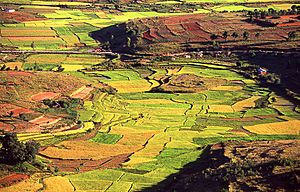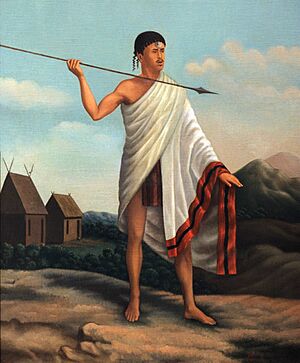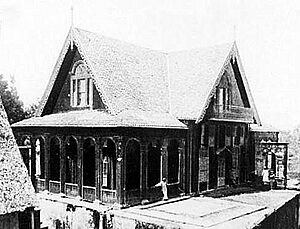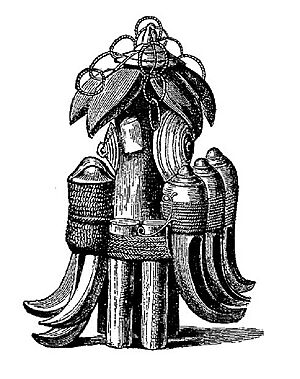Merina Kingdom facts for kids
Quick facts for kids
Kingdom of Imerina
Fanjakan'Imerina
|
|||||||
|---|---|---|---|---|---|---|---|
| 1540–1897 | |||||||
|
|
|||||||
|
Motto: "Tsy adidiko izaho samy irery, fa adidiko izaho sy ianao" (Malagasy)
"It is not only my responsibility, but ours: mine and yours" |
|||||||
|
Anthem: Andriamanitra ô! Tahionao ny Mpanjakanay
O God, bless our Queen |
|||||||
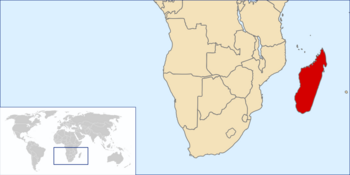
Location of Madagascar in Africa
|
|||||||
| Capital and largest city
|
Antananarivo 18°55′25″S 47°31′56″E / 18.92361°S 47.53222°E |
||||||
| Common languages | Malagasy | ||||||
| Religion | Traditional beliefs, Protestantism (from 1869) | ||||||
| Government | Semi-feudal absolute monarchy (1540–1863) Unitary semi-feudal constitutional monarchy (1863–1897) |
||||||
| Monarch | |||||||
|
• 1540–1575 (first)
|
Andriamanelo | ||||||
|
• 1883–1897 (last)
|
Ranavalona III | ||||||
| Prime Minister | |||||||
|
• 1828–1833 (first)
|
Andriamihaja | ||||||
|
• 1896–1897 (last)
|
Rasanjy | ||||||
| Historical era | Pre-colonial | ||||||
|
• Accession of King Andriamanelo
|
1540 | ||||||
|
• French capture of the royal palace
|
1897 | ||||||
|
|||||||
| Today part of | Madagascar | ||||||
The Kingdom of Merina, also known as the Kingdom of Madagascar, was a powerful state that existed from around 1540 to 1897. It was located off the coast of Southeast Africa on the island of Madagascar. By the 18th century, this kingdom controlled most of the island.
The kingdom started in a region called Imerina, located in the Central Highlands. This area was mainly home to the Merina ethnic group. Their spiritual capital was Ambohimanga, and their political capital, Antananarivo, is now the capital of modern Madagascar. The kings and queens who ruled Madagascar in the 19th century were descendants of a long line of Merina royalty. The first of these rulers was Andriamanelo, who is believed to have founded Imerina in 1540.
In 1883, France invaded the Merina Kingdom. They wanted to create a protectorate, which meant France would control the kingdom's foreign affairs. France invaded again in 1894 and took over the kingdom completely. This led to Madagascar becoming a French colony in 1897. These events are known as the Franco-Hova Wars.
Contents
History of the Merina Kingdom
Early Conflicts and Growth
Madagascar's central highlands were first settled between 200 BC and 300 AD. These early settlers were the Vazimba, who built simple villages. By the 15th century, the Hova people moved into the highlands. They built their own hilltop villages near the Vazimba settlements.
For many years, the Hova and Vazimba lived together peacefully. They even married each other. A Vazimba queen married a Hova man named Manelobe. Their son, Andriamanelo (ruled 1540–1575), changed this. He started a war to take control of the Vazimba communities. He forced them to join the Hova or leave the area.
Andriamanelo's son, Ralambo (ruled 1575–1612), became a very important ruler. He was the first to call the central highland area "Imerina," meaning "Land of the Merina people." Ralambo expanded his kingdom using both diplomacy and military strength. He got the first firearms in Imerina by trading with coastal kingdoms.
Ralambo also created the first permanent Merina royal army. He introduced a tax called the vadin-aina to support his army. He also started the tradition of domesticating wild zebu cattle for food. He introduced the fandroana ceremony, a "Royal Bath" to celebrate his discoveries.
Establishing the Capital
Andrianjaka (ruled 1612–1630) followed his father Ralambo. He led a successful military campaign to capture the last major Vazimba stronghold. This was on the hill of Analamanga. There, he built a fortified compound called a rova. This became the center of his new capital city, Antananarivo.
The first buildings inside this compound, known as the Rova of Antananarivo, were royal houses and tombs. These buildings became very important politically and spiritually. Andrianjaka also got many firearms and gunpowder. These helped him expand his rule over Imerina.
Expanding the Kingdom
From the 16th century, the Merina and Sakalava kingdoms often fought. The Sakalava would raid Imerina to capture people. By the early 19th century, the Merina had grown stronger. They were able to defeat rival tribes like the Bezanozano and Betsimisaraka. Eventually, they also brought the Sakalava kingdom under their control.
The name "Merina" became common because it means "prominence" in the Malagasy language. Some people saw this expansion as a way to unite Madagascar. However, neighboring tribes like the Betsimisaraka saw it as an invasion. By 1824, the Merina captured the port of Mahajanga on the western coast.
Under King Radama I, the Merina continued their military expeditions. These expeditions helped expand their control and made military leaders wealthy. The British helped the Merina by providing firearms and military training. The British wanted to trade with the Merina kingdom because of its central location.
After 1828, Merina expeditions became more frequent. These campaigns led to many people being killed or enslaved. Many people tried to escape Merina rule. These refugees sometimes formed groups that raided villages. Imperial troops hunted them down. The demand for enslaved people in the Merina kingdom grew. This led to even more military expansion. By the mid-19th century, the Merina kingdom controlled most of the island. It almost united all of Madagascar before French colonization in 1895.
Reuniting the Kingdom
King Andriamasinavalona had divided the kingdom among his four sons. This led to constant fighting between different parts of Imerina. However, he did expand the kingdom to its largest size before this division.
In 1787, Prince Ramboasalama, a nephew of King Andrianjafy, took the throne. He became King Andrianampoinimerina. He used both diplomacy and force to reunite Imerina. His goal was to bring all of Madagascar under his rule.
The Kingdom of Madagascar
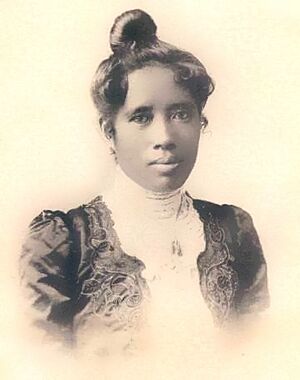
Andrianampoinimerina's son, Radama I, largely completed this goal. He was the first to welcome European missionaries and diplomats to Antananarivo.
Queen Ranavalona I, Radama I's widow, ruled for 33 years. She tried to keep Madagascar isolated from modern European influences. Her son, King Radama II, signed a treaty called the Lambert Charter. This gave a French businessman special rights to many of the island's resources. His policies made the aristocracy angry. Prime Minister Rainivoninahitriniony had the King killed in a coup d'état.
After this, Rasoherina, the queen dowager, became queen. She agreed to a constitutional monarchy, which gave more power to the Prime Minister. During her rule, the Lambert Charter was canceled. The Merina Kingdom also signed a trade agreement with the United States in 1867. She replaced the Prime Minister with his brother, Rainilaiarivony. He held the role for 30 years and married each queen who followed.
The next queen, Ranavalona II, made Christianity the official religion. She had all the sampy (royal talismans) burned in public. The last Merina queen, Ranavalona III, became queen at age 22. She was later sent away to Réunion Island and then French Algeria. This happened after France took over the island in 1896.
French Colonization
France was angry about the cancellation of the Lambert Charter. They also wanted to get back property taken from French citizens. So, France invaded Madagascar in 1883. This was the First Franco-Hova War. After the war, Madagascar gave Antsiranana (Diégo Suarez) to France. They also paid money to the family of Joseph-François Lambert.
In Europe, diplomats were dividing up Africa. Britain agreed to give up its claims to Madagascar in favor of France. This was bad for the Merina monarchy. Prime Minister Rainilaiarivory had been able to play Britain and France against each other. But now, France could interfere without worrying about Britain.
In 1895, a French army landed in Mahajanga and marched to the capital, Antananarivo. They surprised the city's defenders, who expected an attack from the east coast. Twenty French soldiers died in battle. However, 6,000 died from malaria and other diseases. This ended the Second Franco-Hova War. In 1896, the Merina Kingdom became a French protectorate. In 1897, the French Parliament voted to take over the island as a colony. This officially ended Merina rule.
Geography of Imerina
Organizing the Land
Andriamanelo built the first fortified royal compound, or rova, in his capital at Alasora. This fortified palace had special features. These included hadivory (dry moats), hadifetsy (defensive trenches), and vavahady (town gates with a large rolling stone barrier). These features made the town safer from Vazimba attacks.
Andrianjaka's rules increased the separation between the king and his people. He divided society into different groups. Each group was assigned to a specific area within his kingdom.
Andrianjaka united the areas on what he called the twelve sacred hills of Imerina. These hills became, and still are, the spiritual heart of Imerina. Later, Andrianampoinimerina expanded this idea. He named new hills as sacred.
Under Andriamasinavalona, the Kingdom of Imerina had six provinces. These included Antananarivo and areas to the northeast. Andrianampoinimerina reunited these provinces. He also added new areas to the west and northwest. These areas form the core land of Imerina, the homeland of the Merina people.
The word Imerina comes from a Malagasy word meaning "occupancy of a prominent place." This fits well, as much of the land was used to build palaces for royalty or temples. Andrianampoinimerina was the first to use the name Imerina after conquering Antananarivo. He built a palace there, which became the main seat of royal power.
A major change to the land under Andrianampoinimerina was the introduction of irrigation systems. These allowed for the farming of rice paddies. Rice is still a main food in Malagasy cuisine today. Canals and dikes were built by many enslaved people. This work was part of fanompoana, or royal service.
The landscape of Imerina and how it was shaped had important ritual meaning. The irrigation system in Antananarivo represented the unity between the Merina royalty and its people. This was similar to the tsodrano ritual. In this ritual, water was sprinkled to show the unity of land and people. Merina beliefs highly valued the connection between history and the land. Using water to represent spiritual connections is still common today.
By the 1820s, more Europeans arrived in Imerina. They brought many Western plants and trees. These grew well in Madagascar's soil and climate.
Social Structure
Social Classes
Before the Merina kingdom was united, society had two main groups. There were small princes and large groups of peasants.
Andriamanelo is said to have formally created the andriana as a class of Merina nobles. This started a structured society. From then on, the term Hova referred only to free people who were not nobles. Later, Andriamanelo's son Ralambo renamed them Merina. Ralambo also divided the andriana noble class into four ranks.
Andrianjaka was the first king buried at the Rova of Antananarivo. His tomb was the first of the Fitomiandalana, seven tombs in a row. To honor him, his people built a small wooden house on top of his tomb. Future Merina rulers and nobles continued this tradition.
After the conquests of the 19th century, about half of the Merina population were descendants of enslaved people. Today, descendants of enslaved people are sometimes called "blacks," and descendants of free people are called "whites." This use of color also relates to the racial features of the Malagasy population. These features come from the island's first settlers, who had both Austronesian and African backgrounds.
Religious Beliefs
Andriamanelo is credited with bringing astrology to Imerina.
Under Ralambo, the king gained more power to protect the kingdom. This was done by honoring the sampy. These were traditional amulets made from natural materials. Amulets called ody had long been important to many ethnic groups of Madagascar. But these were believed to protect only the person wearing them.
Ralambo received a very powerful sampy called Kelimalaza. It was believed to protect an entire community. He then gathered twelve more powerful sampy from across Imerina. These sampy were treated like people, with their own personalities and houses. Ralambo changed the relationship between sampy and ruler. Before, sampy were tools for leaders. Under Ralambo, they became divine protectors of the king and the state. They would protect the kingdom if the rulers showed them respect.
By collecting the twelve greatest sampy (twelve was a sacred number), Ralambo strengthened the king's power. Oral history tells of sampy being taken into battle. Victories were often credited to them. Over time, less powerful sampy became common among village chiefs and families. But by the end of Andrianjaka's rule, only the twelve "Royal Sampy" remained. These royal sampy were worshipped until Queen Ranavalona II supposedly burned them in 1869. This happened when she publicly converted to Christianity.
The annual fandroana festival also began under Ralambo. This festival was held at the start of each year. Family members were expected to reunite in their home villages. Homes were cleaned, and new clothes were bought. The festival symbolized renewal. On the first day of the year, a red rooster was sacrificed. Its blood was used to bless the king and others. The king would then bathe in sacred water and sprinkle it on attendees for purification. Children would carry lighted torches through their villages at night. Zebu meat, especially jaka, was eaten during the festival. Jaka was shredded zebu meat preserved in a clay jar for a year.
Customs and Traditions
The marriage tradition of vodiondry is still practiced today. It is said to have started with Andriamanelo. He sent gifts, including vodiondry (meat from a sheep's hindquarters), to his bride's family. He believed this was the tastiest part. Ralambo also valued this cut of meat. He declared that the hindquarters of every zebu killed in the kingdom belonged to him. From Andriamanelo's time, grooms offered vodiondry to the bride's family. Over time, money and other gifts replaced the meat.
Andriamanelo's son Ralambo is also credited with introducing polygamy in Imerina. He also introduced family intermarriage among Merina nobles.
The tradition of long mourning periods for deceased rulers may have started with Andrianjaka's death. He was followed by his son, Andriantsitakatrandriana.
Despite different religious beliefs, ritual circumcision has remained important in Merina and Malagasy culture. It continues to be practiced today.
Indigenous silk clothing, called landibe, is very important in highland cultures. It was worn during ancestral funerary ceremonies.
The Tantaran'ny Andriana, or Histories of Kings, is a classic Merina book. It was put together by Jesuit priest François Callet in the 1860s from oral stories. This book and other printed works are highly valued.
Modern Malagasy culture is still strongly connected to the past. Many ceremonies involve reenacting past events. For example, tromba is a spirit possession ceremony. In Madagascar, history is often about feeling and experiencing, rather than just knowing facts.
Political Structure
Royal Succession
The Merina kingdom used a system called fanjakana arindra, meaning "organized government." This system was set up by the Vazimba noblewomen who raised Andriamanelo. The Vazimba often preferred queens, while the Hova preferred male heirs. To avoid conflict, Andriamanelo's mother decided he would inherit the crown. But he would be followed by his younger brother, not his own child. This rule applied to families too. Parents would choose an older child to lead the family. If that child died, authority would pass to a designated younger child.
Ralambo was the first Merina ruler to practice polygamy. His second wife gave him a son. While his younger son was supposed to rule, Ralambo wanted to please his elder son. So, he declared that the crown could only pass to a child born from the reigning ruler and a princess from the elder son's family line.
The practice of honoring deceased Merina rulers is believed to have started with Ralambo.
Capital and Royal Residences
Imerina was first ruled by Andriamanelo from his mother's village, Alasora. His son Ralambo moved the capital to Ambohidrabiby. Andrianjaka moved his capital from Ambohidrabiby to Ambohimanga around 1610.
The Besakana, Masoandrotsiroa, and Fitomiandalana houses at the Rova of Antananarivo were kept and maintained for centuries. This gave them deep symbolic and spiritual meaning. The Besakana was especially important as Andrianjaka's home. It was rebuilt several times in the same design by later kings. Kings were crowned in this building, and their bodies were displayed here before burial. Besakana was seen as "the official state room for civil affairs" and "the throne of the kingdom."
Defense and Justice
The early Merina fighters used iron-tipped spears. This innovation is credited to Andriamanelo. He may have been the first among the Hova to use iron in this way.
Andrianjaka made a big change to the traditional justice system. This was called the trial by ordeal. Before, an accused person's rooster would be given tangena poison to see if it survived. If it did, the person was innocent. Andrianjaka changed this so the accused person had to drink the poison themselves.
Economy and Trade
Farming and Resources
Andriamanelo was the first in the highlands to turn lowland swamps into irrigated rice paddies. He did this by building dikes around Alasora. Under Andrianjaka, the plains around Antananarivo became large, productive rice paddies. This was done by mobilizing many people to build dikes. These dikes redirected rainwater to flood planted areas.
Andrianjaka was reportedly the first Merina leader to meet Europeans around 1620. He traded enslaved people for guns and gunpowder. This helped him control rival areas. He got 50 guns and three barrels of gunpowder for his army.
The Slave Trade
Exporting Enslaved People
People captured from tribal raids became part of the Malagasy enslaved population. Extra enslaved people were sent to foreign traders on the coast. These traders were first Arab and Indian. Europeans began to join them in the 16th century. Malagasy enslaved people were sent to Arabia, India, Réunion, Mauritius, and the Americas, mainly Brazil.
After the Napoleonic Wars, the British took over the French Mascarene Islands east of Madagascar. These islands helped in the trade of enslaved people and farm products. Some of the first stories about Madagascar in Britain came from Robert Drury. He was a shipwrecked British sailor who wrote about the Malagasy slave trade. This interest in the slave trade drew the British to the Merina. This gave the Merina the weapons to expand their kingdom and trade networks.
The British later gave Réunion back to France. But they kept Mauritius. In 1820, a treaty between Britain and Merina ended the export of enslaved people from Madagascar. However, the internal trade of enslaved people still grew after 1820. It is estimated that 6,000 to 10,000 enslaved people were exported from Antananarivo each year by 1820. In 1828, Ranavalona I canceled the treaty. By 1836, she had expelled most foreigners from Madagascar.
Slavery Within the Kingdom
Madagascar had a low population density. So, domestic slavery was a way to control resources and people. The Merina elite relied heavily on slave labor. Because of this, King Radama I did not fully follow the first British-Merina treaty signed in 1817. Owning enslaved people became more common in the following decades. As the enslaved population grew, more Merina people owned them.
As imperial conquests increased the supply of enslaved people, Antananarivo's population grew. It went from about 10,000 in 1820 to 50,000 in 1833. The demand for enslaved people matched the supply. This was because fanompoana, or mandatory military service, took free men away from farm work. In the second half of the 19th century, the Merina began to import enslaved people from East Africa. This was due to an economy that depended on slave labor. Also, Merina court officials had personal financial interests.
The freeing of domestic slaves began in 1877. About 150,000 enslaved people were freed. However, these newly freed people became an imperial labor reserve. This was a position similar to enslavement. A secret trade continued in the 1880s until Franco-Merina hostilities began in 1882.
See also
- List of Imerina monarchs





